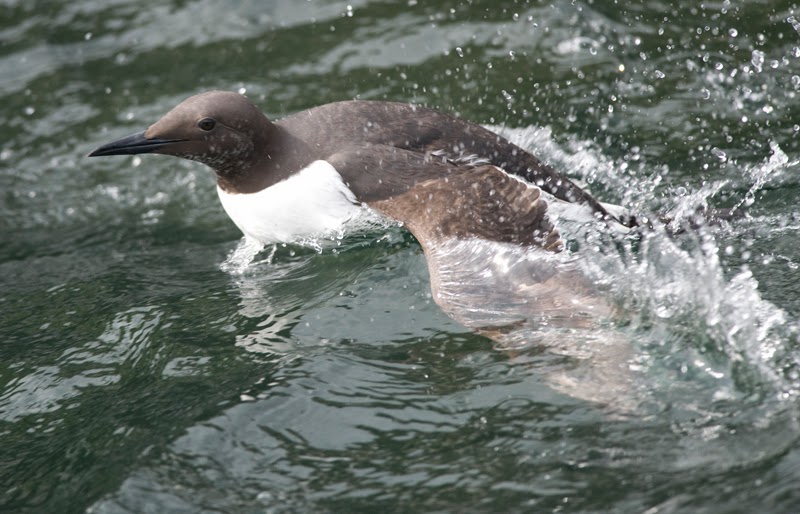A bit about the Farnes. They lie off the Northumberland coast, just north of the small town/big village of Seahouses, from where the boat trips leave. The National Trust looks after the islands, and boats can land at just three of them (Inner Farne, Staple and Longstone, the latter a backup option for when the tricky landing at Staple isn't possible). Inner Farne is part of the inner group, Staple part of the outer group. The most numerous breeding species on the islands (by a large margin) are Guillemots and Puffins, but other typical cliff-nesters are present too, also Arctic Terns and Eiders.
Most people who visit the Farnes go to see the Puffins, and they don't leave disappointed. There are more than 30,000 pairs here, and both Inner Farne and Staple have lots of them. They are feeding chicks now and many of the birds whizzing about were laden with sandeels.
This group, though, I think were non-breeders, just hanging out on the clifftop rather than near the burrows.
I spent lots of time trying for flight shots. These are some of the more successful ones. They are very fast in flight, but also very direct, so are easy-ish to follow once you lock on, and if you stand at the right spot they will fly very close to you. Using the full-frame camera, and the bare 300mm lens rather than lens + teleconverter, made the task easier.
A couple on the deck. Again, easy to get close, although I was lucky to manage a shot of one carrying fish...
... because of this. On both islands, a large contingent of gulls (Black-headed plus a few Herring and Lesser Black-backed) loiter on the Puffin nesting areas, and when a bird returns with fish, they attempt to mug it as it rushes to its burrow. Often the gulls either grabbed the fish or scared the Puffin so badly that it dropped its catch.
As your boat nears the islands, the number of Guillemots on the sea increases until you're among vast rafts of them. These birds are resting and bathing, rather than actively feeding - that happens a bit further out.
If the boat's too close, the Guillemots 'escape' by rushing along the surface with their wings beating.
Before we landed at Staple, we sailed around it a bit to look at the Guillemots and other seabirds on the clifftop and ledges.
Guillemots of the 'bridled' form were few and far between.
Those wings barely look capable of flight. But they are quick on the wing, though not exactly agile.
Yet another flight shot.
Guillemots (and Puffins for that matter) do a lot of flapping. Some individuals of both species were also pretty grubby, presumably because of the rain making for muddy surfaces.
A Guillemot from Inner Farne, going past one of the Billy Shiel boats.
Razorbill is the scarcest auk here, with only about one pair per 100-150 Guillemot pairs.
This one's pose reminds me of an orchestra conductor. Fortissimo!
And these two were happily canoodling, ignoring the row of photographers about one metre away from them.
Part 2 will cover the other Farnes birds, and part 3 will be stuff I saw on the mainland around Seahouses.



















No comments:
Post a Comment